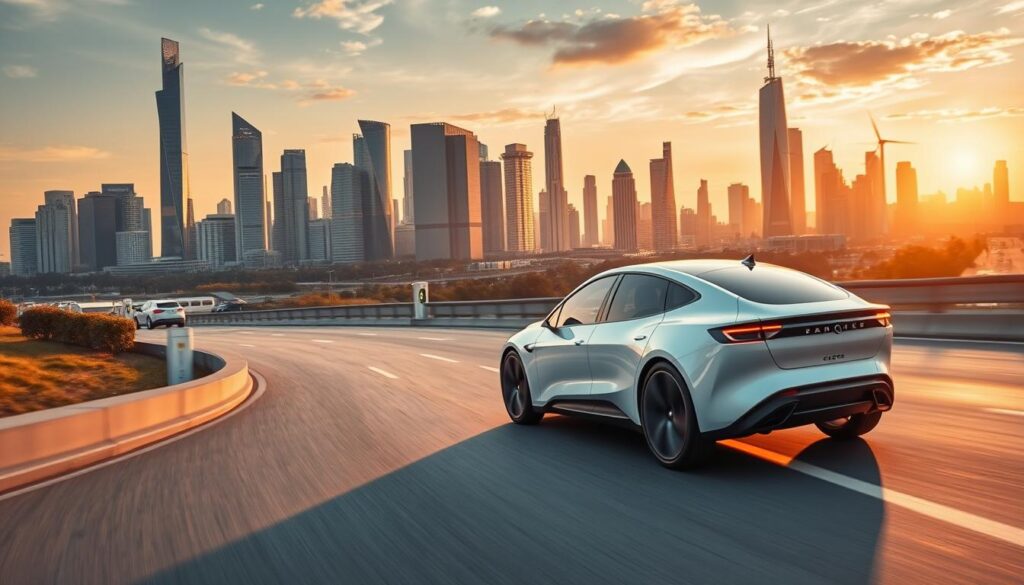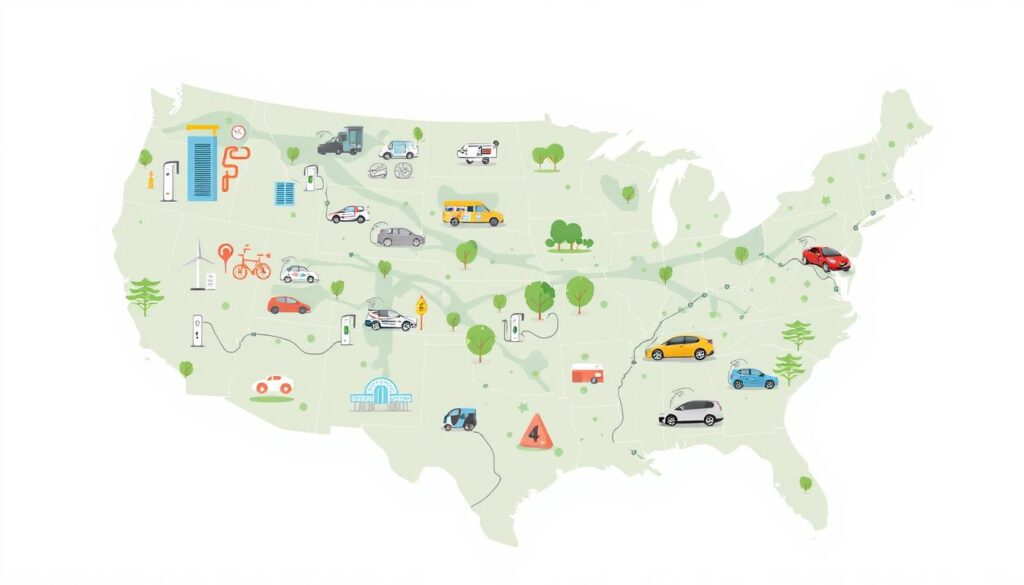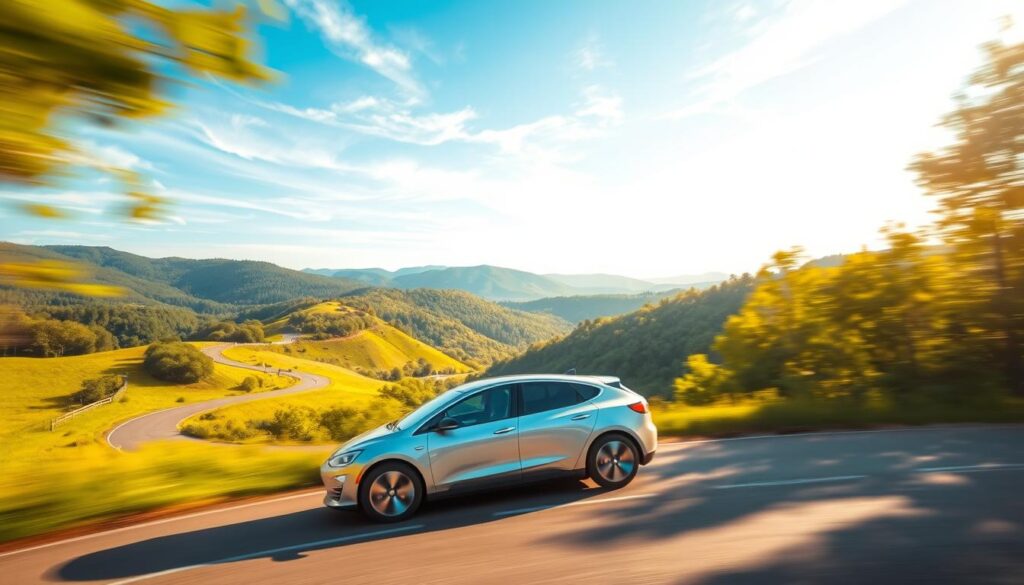The transportation sector is undergoing a significant transformation, driven by the need to reduce its substantial environmental footprint. As we witness a transformative era in transportation, electric vehicles and sustainable mobility solutions are reshaping how we move around our cities and beyond.
We’re seeing a shift towards electrification and integration of various transport modes to mitigate environmental impacts. The U.S. transportation sector accounts for approximately 30% of total energy needs and 70% of petroleum consumption, highlighting the need for sustainable solutions. According to McKinsey’s insights, the demand for passenger cars in the battery electric vehicle segment is projected to grow significantly.
Key Takeaways
- The transportation sector is a significant contributor to greenhouse gas emissions.
- There’s a growing shift towards electrification and sustainable mobility solutions.
- The U.S. transportation sector accounts for a substantial portion of energy needs and petroleum consumption.
- Demand for electric vehicles is expected to grow significantly in the coming years.
- Sustainable mobility solutions are reshaping the future of transportation.
The Current State of Electric Vehicles in 2024
In 2024, the electric vehicle sector is witnessing unprecedented expansion worldwide. This growth is driven by technological advancements, environmental concerns, and shifting consumer preferences.
Global EV Market Growth and Adoption Rates
The global electric vehicle market is growing rapidly, with increasing adoption rates in various regions. Key factors contributing to this growth include government incentives, declining battery costs, and expanding charging infrastructure.
- Rising demand for EVs due to environmental awareness
- Government policies supporting the adoption of electric vehicles
- Advancements in battery technology improving vehicle range
Regional Differences in EV Penetration
Regional differences in EV penetration are significant, with some countries leading the way in adoption. Norway, for example, has one of the highest per-capita EV adoption rates due to favorable policies and incentives.
China’s Emerging Dominance in the EV Market
China is emerging as a dominant player in the global electric vehicle market. The country’s integrated value chain allows local companies to produce EVs at competitive prices, giving them an edge in the global market. Chinese EV manufacturers are not only seeing strong domestic sales but also have ambitious plans to export their vehicles, further expanding their global footprint.
Latest Trends in Electric Vehicles and Sustainable Transportation
The future of transportation is being shaped by innovative trends in electric vehicles and sustainable mobility solutions. We’re witnessing a significant shift towards more sustainable and efficient transportation options.
Battery Technology Advancements and Range Improvements
Advancements in battery technology are crucial for the continued growth of the electric vehicle market. Improvements in battery range and efficiency are making electric vehicles more appealing to consumers. Range improvements are particularly important, as they address one of the primary concerns of potential electric vehicle buyers: range anxiety.
Integration of Renewable Energy Sources
The integration of renewable energy sources into the electric vehicle ecosystem is gaining momentum. As we transition to cleaner energy, the environmental benefits of electric vehicles will continue to increase. Sustainable transport solutions are becoming more prevalent, supporting the growth of the electric vehicle market.
Micromobility Solutions and Their Growing Popularity
Micromobility solutions, such as e-bikes and electric scooters, are experiencing rapid growth. These solutions offer convenient, cost-effective, and efficient transportation options for short distances, particularly in urban environments. The global micromobility market is projected to reach $360 billion by 2030, driven primarily by e-bike sales. 
As consumers increasingly adopt micromobility options, we can expect to see significant changes in urban transportation planning and personal mobility preferences.
Shifting Consumer Preferences in Mobility
We’re witnessing a paradigm shift in how consumers approach mobility, driven by changing lifestyles and technological innovations. The way people move is becoming more diverse, with various factors influencing their choices.
From Ownership to Usership Models
The traditional model of vehicle ownership is giving way to usership models. Consumers are increasingly opting for mobility services that offer flexibility and convenience. This shift is driven by the desire for cost savings and reduced maintenance responsibilities.
Sustainability as a Driving Factor
Sustainability has become a key consideration in consumer choices. With growing environmental concerns, consumers are leaning towards eco-friendly options. This trend is influencing the demand for electric vehicles and other sustainable mobility solutions.
Digital Connectivity and Vehicle Features
Consumers now expect their vehicles to be equipped with advanced technology and features. The demand for enhanced services, such as over-the-air updates and improved connectivity, is on the rise. Data shows that 69% of consumers want more car connectivity services, and 34% are interested in L4 automation features. This shift is reshaping how manufacturers design and market their vehicles, with a focus on meeting evolving consumer preferences.

Infrastructure Development for Electric Mobility

The United States is witnessing a significant surge in investments and initiatives aimed at bolstering its EV charging infrastructure. We’re seeing a collaborative effort among various stakeholders, including charging equipment manufacturers, automakers, utilities, and government agencies, to rapidly establish a national network of public charging stations.
Charging Networks Expansion
Substantial investments are being tracked in charging infrastructure from both public and private sectors. Federal initiatives like the National Electric Vehicle Infrastructure (NEVI) program are providing crucial funding to states for strategic deployment of fast-charging stations along major transportation corridors.
Smart Grid Integration
Utilities are increasingly involved in infrastructure development, leveraging their electrical expertise and grid knowledge to strategically place and power charging stations. This integration is crucial for a sustainable and efficient charging network.
Public and Private Investment
Private charging network operators are complementing government efforts with their own expansion plans, focusing on urban areas and commercial locations with high traffic. These combined efforts are accelerating the deployment of charging stations across diverse locations.
Economic Factors Shaping EV Adoption
Economic considerations are at the forefront of the electric vehicle revolution. As we continue to transition towards sustainable mobility, understanding the economic factors that influence the adoption of electric vehicles (EVs) is crucial.
Total Cost of Ownership Analysis
The total cost of ownership for EVs is becoming increasingly competitive with conventional vehicles. Lower operating costs, including reduced fuel and maintenance expenses, contribute to the overall value of EVs. As battery costs decline, the initial purchase price of EVs is also becoming more affordable.
Government Incentives and Federal Tax Credits
Government incentives, such as federal tax credits for electric vehicles, play a significant role in encouraging their adoption. These incentives help offset the higher upfront costs associated with EVs. The query for electric vehicle tax credits United States is a clear indication of the public’s interest in understanding the available benefits.
Price Parity Timeline with Conventional Vehicles
Industry analysts project that upfront price parity between EVs and conventional vehicles will be achieved in most segments by 2025-2027. Key factors driving this convergence include declining battery costs, which represent approximately 30-40% of an electric vehicle’s value, and increasing manufacturing volumes. Some vehicle categories have already reached price parity, particularly in the luxury and performance segments.
- We’re tracking the convergence of electric and conventional vehicle pricing.
- Battery costs continue to decline through technological improvements and manufacturing scale.
- Smaller vehicles are expected to reach parity sooner than larger SUVs and trucks.
Autonomous Driving and Connected Mobility
We’re witnessing a significant shift towards autonomous driving and connected mobility, transforming the way we travel.
Current State of Autonomous Vehicle Technology
Autonomous vehicle technology is advancing rapidly, with significant investments in AI and sensor technologies. These advancements are enabling vehicles to navigate complex environments more safely and efficiently.
Integration of EVs with Autonomous Systems
The integration of electric vehicles (EVs) with autonomous systems is a key trend. This combination offers improved safety, reduced emissions, and enhanced mobility services.
Mobility-as-a-Service (MaaS) Platforms
Mobility-as-a-Service (MaaS) platforms are revolutionizing transportation by integrating various mobility options into a single, convenient service. MaaS enhances user convenience by providing seamless journey planning, booking, and payment systems.
These platforms are breaking down traditional boundaries between public transit, ride-hailing, and car-sharing, creating unified mobility ecosystems that offer personalized recommendations and subscription packages, representing a fundamental shift in how people think about transportation.
Environmental Impact and Sustainability Benefits
The growing popularity of electric vehicles is a crucial step towards reducing our reliance on fossil fuels and mitigating environmental damage. As we adopt this cleaner mode of transportation, we can expect significant improvements in various areas.
Greenhouse Gas Emission Reductions
One of the most significant benefits of electric vehicles is the reduction in gas emissions. By switching to electric power, we can decrease the amount of greenhouse gases emitted into the atmosphere, contributing to a cleaner environment.
Life Cycle Assessment of Electric Vehicles
Studies have shown that while the production of electric vehicles may have a higher environmental impact, their overall life cycle assessment is more favorable due to reduced emissions during operation. This makes them a more sustainable choice in the long run.
Public Health Improvements from Reduced Emissions
We’re documenting substantial public health benefits in areas with increasing electric vehicle adoption. The elimination of tailpipe emissions reduces harmful pollutants, improving air quality and contributing to better public health.

Conclusion: The Road Ahead for Sustainable Mobility
We’re on the cusp of a revolution in how we move people and goods, driven by electric vehicles and sustainable mobility. As we navigate this shift, it’s clear that the future of transportation is not just about changing the technology, but about reimagining the entire mobility ecosystem.
The transition to electric mobility is gaining momentum, despite ongoing challenges such as charging infrastructure gaps and battery material supply constraints. However, with continued efforts from governments, industry, and communities, we’re making significant progress.
The mobility landscape is becoming more diverse, with electric vehicles of various sizes complemented by enhanced public transit, shared mobility services, and micromobility solutions. Ensuring convenience and accessibility of charging options will be crucial for widespread adoption.
As we move forward, prioritizing actions that offer the most significant environmental benefits while ensuring mobility for all is essential. The journey toward a sustainable transport future is a collective endeavor, and together, we can create a cleaner, more efficient world. For personalized guidance on transitioning to electric mobility, contact us via WhatsApp at +44-7822010953.


